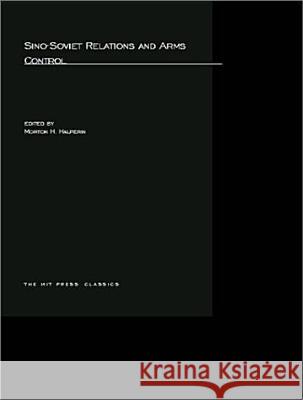Sino-Soviet Relations and Arms Control » książka
Sino-Soviet Relations and Arms Control
ISBN-13: 9780262582285 / Angielski / Miękka / 2003 / 342 str.
Arms control and security issues have been at the heart of much of Russian-Chinese disagreement since the opening of the rift in the 1950's. This book, which offers the work of a group of distinguished contributors, is designed to clarify the bearing of the arms control issue on the Sino-Soviet dispute and to suggest future policy directions for the United States. Specifically, the contributors seek to illuminate the security problems facing the United States and to examine the prospects for arms control as they are affected by conflict within the Communist world.Sino-Soviet Relations and Arms Control begins with the observation that the Soviet Union and Communist China use disarmament talk as a way of pointing out issues of major importance in their dispute, of competing for support within the third world and the Communist bloc, and of expressing genuine disagreement over the fundamental causes of the Sino-Soviet rift.The first section of the book deals with the impact of the Sino-Soviet dispute on the arms control policies of the Soviet Union, China, and the United States. The authors argue that arms control is possible without China, that the Chinese are unlikely to be interested in arms control agreements in the near future, and that arms control could be of paramount importance to relations among the three countries. Part II of the book is a historical exploration of the interrelation between specific arms control measures and the Sino-Soviet dispute. The authors give the most detailed account yet available of Sino-Soviet nuclear relations between 1957 and 1960 and document the extent to which the quarrel has centered on military and security issues. The role of the test ban in widening the Sino-Soviet rift is explored. In Part III each author poses the same question: what would be the nature of Sino-Soviet relations during a Washington-Peking crisis? The first three chapters in this section answer the question from the viewpoint of each country concerned; the last examines these relations during the 1958 Quemoy crisis.Definitive information on the events pertinent to the Sino-Soviet dispute of the 1950's and early 1960's is rare; although It does not pretend to tell the entire story, this book makes a significant contribution to the body of knowledge on the evolution of the Sino-Soviet dispute. As a learned, perceptive comment on the security problems created by the dispute and on the possibilities for agreement that it presents, Sino-Soviet Relations and Arms Control will have a wide audience among political scientists, specialists in Sino-Soviet affairs, and a lay public that recognizes the importance of this political issue.











